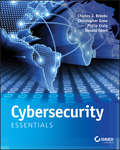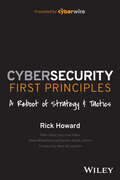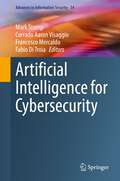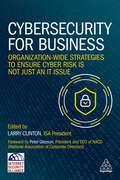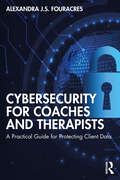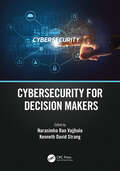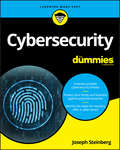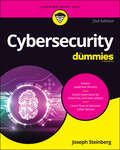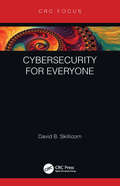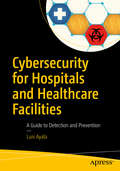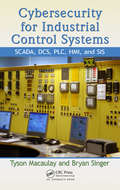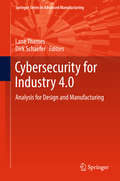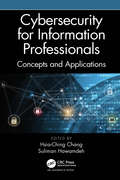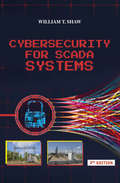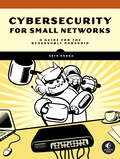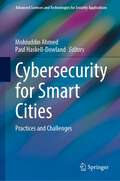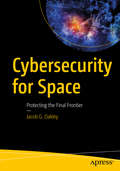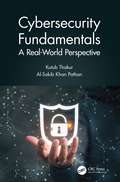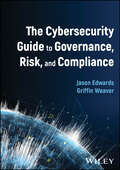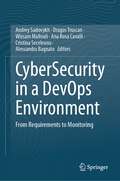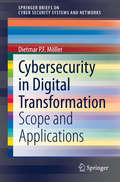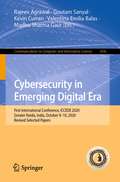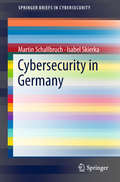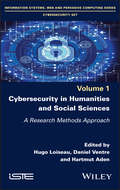- Table View
- List View
Cybersecurity Essentials
by Charles J. Brooks Christopher Grow Philip Craig Donald ShortAn accessible introduction to cybersecurity concepts and practices Cybersecurity Essentials provides a comprehensive introduction to the field, with expert coverage of essential topics required for entry-level cybersecurity certifications. An effective defense consists of four distinct challenges: securing the infrastructure, securing devices, securing local networks, and securing the perimeter. Overcoming these challenges requires a detailed understanding of the concepts and practices within each realm. This book covers each challenge individually for greater depth of information, with real-world scenarios that show what vulnerabilities look like in everyday computing scenarios. Each part concludes with a summary of key concepts, review questions, and hands-on exercises, allowing you to test your understanding while exercising your new critical skills. Cybersecurity jobs range from basic configuration to advanced systems analysis and defense assessment. This book provides the foundational information you need to understand the basics of the field, identify your place within it, and start down the security certification path. Learn security and surveillance fundamentals Secure and protect remote access and devices Understand network topologies, protocols, and strategies Identify threats and mount an effective defense Cybersecurity Essentials gives you the building blocks for an entry level security certification and provides a foundation of cybersecurity knowledge
Cybersecurity First Principles: A Reboot of Strategy and Tactics
by Rick HowardThe first expert discussion of the foundations of cybersecurity In Cybersecurity First Principles, Rick Howard, the Chief Security Officer, Chief Analyst, and Senior fellow at The Cyberwire, challenges the conventional wisdom of current cybersecurity best practices, strategy, and tactics and makes the case that the profession needs to get back to first principles. The author convincingly lays out the arguments for the absolute cybersecurity first principle and then discusses the strategies and tactics required to achieve it. In the book, you'll explore: Infosec history from the 1960s until the early 2020s and why it has largely failed What the infosec community should be trying to achieve instead The arguments for the absolute and atomic cybersecurity first principle The strategies and tactics to adopt that will have the greatest impact in pursuing the ultimate first principle Case studies through a first principle lens of the 2015 OPM hack, the 2016 DNC Hack, the 2019 Colonial Pipeline hack, and the Netflix Chaos Monkey resilience program A top to bottom explanation of how to calculate cyber risk for two different kinds of companies This book is perfect for cybersecurity professionals at all levels: business executives and senior security professionals, mid-level practitioner veterans, newbies coming out of school as well as career-changers seeking better career opportunities, teachers, and students.
Cybersecurity for Artificial Intelligence (Advances in Information Security #54)
by Mark Stamp Fabio Di Troia Corrado Aaron Visaggio Francesco MercaldoThis book explores new and novel applications of machine learning, deep learning, and artificial intelligence that are related to major challenges in the field of cybersecurity. The provided research goes beyond simply applying AI techniques to datasets and instead delves into deeper issues that arise at the interface between deep learning and cybersecurity.This book also provides insight into the difficult "how" and "why" questions that arise in AI within the security domain. For example, this book includes chapters covering "explainable AI", "adversarial learning", "resilient AI", and a wide variety of related topics. It’s not limited to any specific cybersecurity subtopics and the chapters touch upon a wide range of cybersecurity domains, ranging from malware to biometrics and more.Researchers and advanced level students working and studying in the fields of cybersecurity (equivalently, information security) or artificial intelligence (including deep learning, machine learning, big data, and related fields) will want to purchase this book as a reference. Practitioners working within these fields will also be interested in purchasing this book.
Cybersecurity for Beginners
by Raef MeeuwisseThis book provides an easy insight into the essentials of cybersecurity, even if you have a non-technical background. You may be a business person keen to understand this important subject area or an information security specialist looking to update your knowledge. <p><p>The world has changed more in the past 10 years than in any 10 year period in human history... Technology is no longer a peripheral servant, it shapes our daily lives. Companies that can use technology wisely and well are booming, companies that make bad or no technology choices collapse and disappear. <p><p>The cloud, smart devices and the ability to connect almost any object to the internet are an essential landscape to use but are also fraught with new risks and dangers of a magnitude never seen before. <p><p>Also featuring an alphabetical section at the back of the book to help you translate many of the main cybersecurity technical terms into plain, non-technical English. This is the second edition of this book with updates and additional content. If you are looking for a book on personal cybersecurity steps, try my other publication "How to Keep Your Stuff Safe Online"
Cybersecurity for Business: Organization-Wide Strategies to Ensure Cyber Risk Is Not Just an IT Issue
by Larry ClintonBalance the benefits of digital transformation with the associated risks with this guide to effectively managing cybersecurity as a strategic business issue. Important and cost-effective innovations can substantially increase cyber risk and the loss of intellectual property, corporate reputation and consumer confidence. Over the past several years, organizations around the world have increasingly come to appreciate the need to address cybersecurity issues from a business perspective, not just from a technical or risk angle. Cybersecurity for Business builds on a set of principles developed with international leaders from technology, government and the boardroom to lay out a clear roadmap of how to meet goals without creating undue cyber risk.This essential guide outlines the true nature of modern cyber risk, and how it can be assessed and managed using modern analytical tools to put cybersecurity in business terms. It then describes the roles and responsibilities each part of the organization has in implementing an effective enterprise-wide cyber risk management program, covering critical issues such as incident response, supply chain management and creating a culture of security. Bringing together a range of experts and senior leaders, this edited collection enables leaders and students to understand how to manage digital transformation and cybersecurity from a business perspective.
Cybersecurity for Coaches and Therapists: A Practical Guide for Protecting Client Data
by Alexandra J.S. FouracresThis groundbreaking book filters down the wealth of information on cybersecurity to the most relevant and highly applicable aspects for coaches, therapists, researchers and all other practitioners handling confidential client conversations and data. Whether working with clients online or face to face, practitioners today increasingly rely on the cyberspace as part of their practice. Through a solutions-focused lens, the book provides easy-to-apply practical advice and guidelines using non-technical language, enabling practitioners to mitigate the rising threat of cybercrime, which can no longer be ignored. By the last page the reader will have knowledge and awareness towards: securing devices, spotting financial fraud, mitigating the risks of online communications, operating more securely from a home office and handling a cyber event if one occurs. Clear, concise, and easy to follow, this guide is a pivotal resource for coaches, therapists, researchers and all other practitioners protecting their clients and businesses.
Cybersecurity for Decision Makers
by Cybersecurity Decision Makers Narasimha Rao Vajjhala Kenneth David StrangThis book is aimed at managerial decision makers, practitioners in any field, and the academic community. The chapter authors have integrated theory with evidence-based practice to go beyond merely explaining cybersecurity topics. To accomplish this, the editors drew upon the combined cognitive intelligence of 46 scholars from 11 countries to present the state of the art in cybersecurity. Managers and leaders at all levels in organizations around the globe will find the explanations and suggestions useful for understanding cybersecurity risks as well as formulating strategies to mitigate future problems. Employees will find the examples and caveats both interesting as well as practical for everyday activities at the workplace and in their personal lives. Cybersecurity practitioners in computer science, programming, or espionage will find the literature and statistics fascinating and more than likely a confirmation of their own findings and assumptions. Government policymakers will find the book valuable to inform their new agenda of protecting citizens and infrastructure in any country around the world. Academic scholars, professors, instructors, and students will find the theories, models, frameworks, and discussions relevant and supportive to teaching as well as research.
Cybersecurity For Dummies
by Joseph SteinbergProtect your business and family against cyber attacks Cybersecurity is the protection against the unauthorized or criminal use of electronic data and the practice of ensuring the integrity, confidentiality, and availability of information. Being "cyber-secure" means that a person or organization has both protected itself against attacks by cyber criminals and other online scoundrels, and ensured that it has the ability to recover if it is attacked. If keeping your business or your family safe from cybersecurity threats is on your to-do list, Cybersecurity For Dummies will introduce you to the basics of becoming cyber-secure! You’ll learn what threats exist, and how to identify, protect against, detect, and respond to these threats, as well as how to recover if you have been breached! The who and why of cybersecurity threats Basic cybersecurity concepts What to do to be cyber-secure Cybersecurity careers What to think about to stay cybersecure in the future Now is the time to identify vulnerabilities that may make you a victim of cyber-crime — and to defend yourself before it is too late.
Cybersecurity For Dummies
by Joseph SteinbergExplore the latest developments in cybersecurity with this essential guide Every day it seems we read another story about one company or another being targeted by cybercriminals. It makes some of us wonder: am I safe online? The good news is that we can all be cybersecure—and it doesn’t take a degree in computer science to make it happen! Cybersecurity For Dummies is the down-to-earth guide you need to secure your own data (and your company’s, too). You’ll get step-by-step guidance on how to implement reasonable security measures, prevent cyber attacks, deal securely with remote work, and what to do in the event that your information is compromised. The book also offers: Updated directions on how to prevent ransomware attacks and how to handle the situation if you become a target Step-by-step instructions on how to create data backups and implement strong encryption Basic info that every aspiring cybersecurity professional needs to knowCybersecurity For Dummies is the ideal handbook for anyone considering a career transition into cybersecurity, as well as anyone seeking to secure sensitive information.
Cybersecurity for Everyone
by David B. SkillicornCyberspace is a critical part of our lives. Although we all use cyberspace for work, entertainment, and social life, much of its infrastructure and operation is invisible to us. We spend a big part of our lives in an environment that is almost an essential service but is full of potential dangers: a place where criminals can commit new kinds of crimes, where governments can exert political pressure, and where we can be hurt by the unthinking actions of the bored and careless. Making cyberspace more secure is one of the challenges of our times. This is not only (or perhaps even primarily) a technical challenge. It requires actions by governments and businesses to encourage security whenever possible, and to make sure that their own actions do not undermine it. Unfortunately, many of those in a position to do something about cybersecurity do not have the background to understand the issues fully. Cybersecurity for Everyone will help by describing the issues in a way that is accessible to anyone, but especially those from non-technical backgrounds.
Cybersecurity for Hospitals and Healthcare Facilities: A Guide to Detection and Prevention
by Luis AyalaLearn how to detect and prevent the hacking of medical equipment at hospitals and healthcare facilities. A cyber-physical attack on building equipment pales in comparison to the damage a determined hacker can do if he/she gains access to a medical-grade network as a medical-grade network controls the diagnostic, treatment, and life support equipment on which lives depend. News reports inform us how hackers strike hospitals with ransomware that prevents staff from accessing patient records or scheduling appointments. Unfortunately, medical equipment also can be hacked and shut down remotely as a form of extortion. Criminal hackers will not ask for a $500 payment to unlock an MRI, PET or CT scan, or X-ray machine--they will ask for much more. Litigation is bound to follow and the resulting punitive awards will drive up hospital insurance costs and healthcare costs in general. This will undoubtedly result in increased regulations for hospitals and higher costs for compliance. Unless hospitals and other healthcare facilities take the steps necessary to secure their medical-grade networks, they will be targeted for cyber-physical attack, possibly with life-threatening consequences. Cybersecurity for Hospitals and Healthcare Facilities is a wake-up call explaining what hackers can do, why hackers would target a hospital, the way hackers research a target, ways hackers can gain access to a medical-grade network (cyber-attack vectors), and ways hackers hope to monetize their cyber-attack. By understanding and detecting the threats, you can take action now--before your hospital becomes the next victim. What You Will Learn: Determine how vulnerable hospital and healthcare building equipment is to cyber-physical attack Identify possible ways hackers can hack hospital and healthcare facility equipment Recognize the cyber-attack vectors--or paths by which a hacker or cracker can gain access to a computer, a medical-grade network server, or expensive medical equipment in order to deliver a payload or malicious outcome Detect and prevent man-in-the-middle or denial-of-service cyber-attacks Detect and prevent hacking of the hospital database and hospital web application Who This Book Is For: Hospital administrators, healthcare professionals, hospital & healthcare facility engineers and building managers, hospital & healthcare facility IT professionals, and HIPAA professionals
Cybersecurity for Industrial Control Systems: SCADA, DCS, PLC, HMI, and SIS
by Tyson Macaulay Bryan L. SingerAs industrial control systems (ICS), including SCADA, DCS, and other process control networks, become Internet-facing, they expose crucial services to attack. Threats like Duqu, a sophisticated worm found in the wild that appeared to share portions of its code with the Stuxnet worm, emerge with increasing frequency. Explaining how to develop and im
Cybersecurity for Industry 4.0: Analysis for Design and Manufacturing (Springer Series in Advanced Manufacturing)
by Dirk Schaefer Lane ThamesThis book introduces readers to cybersecurity and its impact on the realization of the Industry 4. 0 vision. It covers the technological foundations of cybersecurity within the scope of the Industry 4. 0 landscape and details the existing cybersecurity threats faced by Industry 4. 0, as well as state-of-the-art solutions with regard to both academic research and practical implementations. Industry 4. 0 and its associated technologies, such as the Industrial Internet of Things and cloud-based design and manufacturing systems are examined, along with their disruptive innovations. Further, the book analyzes how these phenomena capitalize on the economies of scale provided by the Internet. The book offers a valuable resource for practicing engineers and decision makers in industry, as well as researchers in the design and manufacturing communities and all those interested in Industry 4. 0 and cybersecurity.
Cybersecurity for Information Professionals: Concepts and Applications
by Hsia-Ching ChangInformation professionals have been paying more attention and putting a greater focus on privacy over cybersecurity. However, the number of both cybersecurity and privacy breach incidents are soaring, which indicates that cybersecurity risks are high and growing. Utilizing cybersecurity awareness training in organizations has been an effective tool to promote a cybersecurity-conscious culture, making individuals more cybersecurity-conscious as well. However, it is unknown if employees’ security behavior at work can be extended to their security behavior at home and personal life. On the one hand, information professionals need to inherit their role as data and information gatekeepers to safeguard data and information assets. On the other hand, information professionals can aid in enabling effective information access and dissemination of cybersecurity knowledge to make users conscious about the cybersecurity and privacy risks that are often hidden in the cyber universe. Cybersecurity for Information Professionals: Concepts and Applications introduces fundamental concepts in cybersecurity and addresses some of the challenges faced by information professionals, librarians, archivists, record managers, students, and professionals in related disciplines. This book is written especially for educators preparing courses in information security, cybersecurity, and the integration of privacy and cybersecurity. The chapters contained in this book present multiple and diverse perspectives from professionals in the field of cybersecurity. They cover such topics as: Information governance and cybersecurity User privacy and security online and the role of information professionals Cybersecurity and social media Healthcare regulations, threats, and their impact on cybersecurity A socio-technical perspective on mobile cybersecurity Cybersecurity in the software development life cycle Data security and privacy Above all, the book addresses the ongoing challenges of cybersecurity. In particular, it explains how information professionals can contribute to long-term workforce development by designing and leading cybersecurity awareness campaigns or cybersecurity hygiene programs to change people’s security behavior.
Cybersecurity for SCADA Systems
by William T. ShawThe world has changed since the first edition was published in 2006. There have been many technological changes in communications and networking and in other areas of computer science. More focus is given to implementing cybersecurity protections and technical countermeasures. The second edition also takes advantage of the evolved industry-specific cybersecurity standards that have emerged, especially in the electric power and oil-and-gas pipeline industry sectors. Cybersecurity for SCADA Systems, 2nd Edition is intended to provide a general background of SCADA system technology and cybersecurity concepts and technologies, showing how the two can be brought together to safeguard our infrastructure and computer automation systems. This book provides a high-level overview of this unique technology, with an explanation of each market segment. Readers will understand the vital issues and learn strategies for decreasing or eliminating system vulnerabilities. Cybersecurity for SCADA Systems, 2nd Edition is suitable for nontechnical, management-level personnel as well as IT personnel without SCADA experience. Features and Benefits Functional breakdown and explanation of the typical features, capabilities, and components of a SCADA system IT and cybersecurity technology and terminology overview and explanation Industry-specific as well as generalized discussion of SCADA vulnerabilities and available remediation strategies Discussion of physical and electronic security issues and strategies Audience IT personnel Management Students
Cybersecurity for Small Networks: A No-Nonsense Guide for the Reasonably Paranoid
by Seth EnokaA guide to implementing DIY security solutions and readily available technologies to protect home and small-office networks from attack.This book is an easy-to-follow series of tutorials that will lead readers through different facets of protecting household or small-business networks from cyber attacks. You&’ll learn how to use pfSense to build a firewall, lock down wireless, segment a network into protected zones, configure a VPN (virtual private network) to hide and encrypt network traffic and communications, set up proxies to speed up network performance and hide the source of traffic, block ads, install and configure an antivirus, back up your data securely, and even how to monitor your network for unauthorized activity and alert you to intrusion.
Cybersecurity for Smart Cities: Practices and Challenges (Advanced Sciences and Technologies for Security Applications)
by Mohiuddin Ahmed Paul Haskell-DowlandEnsuring cybersecurity for smart cities is crucial for a sustainable cyber ecosystem. Given the undeniable complexity of smart cities, fundamental issues such as device configurations and software updates should be addressed when it is most needed to fight cyber-crime and ensure data privacy. This book addresses the cybersecurity challenges associated with smart cities, aiming to provide a bigger picture of the concepts, intelligent techniques, practices and research directions in this area. Furthermore, this book serves as a single source of reference for acquiring knowledge on the technology, processes and people involved in the next-generation of cyber-smart cities.
Cybersecurity for Space: Protecting the Final Frontier
by Jacob G. OakleyThis is the first book of its kind to cover the unique challenges of creating, maintaining, and operating a system that operates in both outer space and cyber space. It covers the impact that cyber threats can have on space systems and how the cybersecurity industry must rise to meet the threats. Space is one of the fastest growing military, government, and industry sectors. Because everything in today’s world exists within or connected to cyberspace, there is a dire need to ensure that cybersecurity is addressed in the burgeoning field of space operations. You will be introduced to the basic concepts involved in operating space systems that include low earth orbit (LEO), geosynchronous orbit (GEO), and others. Using the related high-level constraints, threats, and vectors, you will be able to frame a clear picture of the need and challenges of bringing cybersecurity to bear on satellites, space vehicles, and their related systems. The author, who has spent seven years in the US Marine Corps and was originally involved in satellite communications and later cyber operations, is now a seasoned cybersecurity practitioner currently implementing cybersecurity vision and strategy to a large portfolio of systems and programs, many focused specifically in space. A published academic and experienced professional, he brings a practical, real-world and tempered approach to securing space vehicles and their systems. What You Will Learn Understand what constitutes a space system and the challenges unique to operations of all spacecraftGet introduced to various space vehicles and their unique constraints and challengesBe aware of the physical and cyber threats to the space vehicle and its ability to fly and orbitKnow the physical and cyber vectors from which threats may manifestStudy the micro- and macro-analysis provided of space system attack scenariosBe familiar with the high-level problems of cybersecurity in the space domain Who This Book Is For This book is written for two audiences: those with a background in space operations as well as those in cybersecurity. It offers the guidance needed to understand the unique challenges to space operations that affect the implementation of cybersecurity.
Cybersecurity Fundamentals: A Real-World Perspective
by Kutub Thakur Al-Sakib Khan PathanCybersecurity Fundamentals: A Real-World Perspective explains detailed concepts within computer networks and computer security in an easy-to-understand way, making it the perfect introduction to the topic. This book covers fundamental issues using practical examples and real-world applications to give readers a rounded understanding of the subject and how it is applied. The first three chapters provide a deeper perspective on computer networks, cybersecurity, and different types of cyberattacks that hackers choose to unleash on cyber environments. It then goes on to cover the types of major computer malware and cybersecurity attacks that shook the cyber world in the recent years, detailing the attacks and analyzing their impact on the global economy. The details of the malware codes that help the hacker initiate the hacking attacks on networks are fully described. It then covers high-tech cybersecurity programs, devices, and mechanisms that are extensively adopted in modern security systems. Examples of those systems include intrusion detection systems (IDS), intrusion prevention systems (IPS), and security firewalls. It demonstrates how modern technologies can be used to create and manage passwords for secure data. This book also covers aspects of wireless networks and their security mechanisms. The details of the most commonly used Wi-Fi routers are provided with step-by-step procedures to configure and secure them more efficiently. Test questions are included throughout the chapters to ensure comprehension of the material. Along with this book’s step-by-step approach, this will allow undergraduate students of cybersecurity, network security, and related disciplines to gain a quick grasp of the fundamental topics in the area. No prior knowledge is needed to get the full benefit of this book.
The Cybersecurity Guide to Governance, Risk, and Compliance
by Jason Edwards Griffin WeaverThe Cybersecurity Guide to Governance, Risk, and Compliance Understand and respond to a new generation of cybersecurity threats Cybersecurity has never been a more significant concern of modern businesses, with security breaches and confidential data exposure as potentially existential risks. Managing these risks and maintaining compliance with agreed-upon cybersecurity policies is the focus of Cybersecurity Governance and Risk Management. This field is becoming ever more critical as a result. A wide variety of different roles and categories of business professionals have an urgent need for fluency in the language of cybersecurity risk management. The Cybersecurity Guide to Governance, Risk, and Compliance meets this need with a comprehensive but accessible resource for professionals in every business area. Filled with cutting-edge analysis of the advanced technologies revolutionizing cybersecurity, increasing key risk factors at the same time, and offering practical strategies for implementing cybersecurity measures, it is a must-own for CISOs, boards of directors, tech professionals, business leaders, regulators, entrepreneurs, researchers, and more. The Cybersecurity Guide to Governance, Risk, and Compliance also covers: Over 1300 actionable recommendations found after each section Detailed discussion of topics including AI, cloud, and quantum computing More than 70 ready-to-use KPIs and KRIs “This guide’s coverage of governance, leadership, legal frameworks, and regulatory nuances ensures organizations can establish resilient cybersecurity postures. Each chapter delivers actionable knowledge, making the guide thorough and practical.” —GARY MCALUM, CISO “This guide represents the wealth of knowledge and practical insights that Jason and Griffin possess. Designed for professionals across the board, from seasoned cybersecurity veterans to business leaders, auditors, and regulators, this guide integrates the latest technological insights with governance, risk, and compliance (GRC)”. —WIL BENNETT, CISO
CyberSecurity in a DevOps Environment: From Requirements to Monitoring
by Andrey Sadovykh Dragos Truscan Wissam Mallouli Ana Rosa Cavalli Cristina Seceleanu Alessandra BagnatoThis book provides an overview of software security analysis in a DevOps cycle including requirements formalisation, verification and continuous monitoring. It presents an overview of the latest techniques and tools that help engineers and developers verify the security requirements of large-scale industrial systems and explains novel methods that enable a faster feedback loop for verifying security-related activities, which rely on techniques such as automated testing, model checking, static analysis, runtime monitoring, and formal methods. The book consists of three parts, each covering a different aspect of security engineering in the DevOps context. The first part, "Security Requirements", explains how to specify and analyse security issues in a formal way. The second part, "Prevention at Development Time", offers a practical and industrial perspective on how to design, develop and verify secure applications. The third part, "Protection at Operations", eventually introduces tools for continuous monitoring of security events and incidents. Overall, it covers several advanced topics related to security verification, such as optimizing security verification activities, automatically creating verifiable specifications from security requirements and vulnerabilities, and using these security specifications to verify security properties against design specifications and generate artifacts such as tests or monitors that can be used later in the DevOps process. The book aims at computer engineers in general and does not require specific knowledge. In particular, it is intended for software architects, developers, testers, security professionals, and tool providers, who want to define, build, test, and verify secure applications, Web services, and industrial systems.
Cybersecurity in Digital Transformation: Scope and Applications (SpringerBriefs on Cyber Security Systems and Networks)
by Dietmar P.F. MöllerThis book brings together the essential methodologies required to understand the advancement of digital technologies into digital transformation, as well as to protect them against cyber threat vulnerabilities (in this context cybersecurity attack ontology is included, modeling different types of adversary knowledge). It covers such essential methodologies as CIA Triad, Security Risk, Likelihood, and Consequence Level, Threat Attack Profiling, Threat Intelligence, Threat Lifecycle and more. The idea behind digital transformation is to use digital technologies not only to replicate an existing process in a digital form, but to use digital technology to transform that process into something intelligent (where anything is connected with everything at any time and accessible and controlled and designed advanced). Against this background, cyber threat attacks become reality, using advanced digital technologies with their extreme interconnected capability which call for sophisticated cybersecurity protecting digital technologies of digital transformation.Scientists, advanced-level students and researchers working in computer science, electrical engineering and applied mathematics will find this book useful as a reference guide. Professionals working in the field of big data analytics or digital/intelligent manufacturing will also find this book to be a valuable tool.
Cybersecurity in Emerging Digital Era: First International Conference, ICCEDE 2020, Greater Noida, India, October 9-10, 2020, Revised Selected Papers (Communications in Computer and Information Science #1436)
by Rajeev Agrawal Goutam Sanyal Kevin Curran Valentina Emilia Balas Madhu Sharma GaurThis book constitutes selected and revised papers from the First International Conference on Cybersecurity in Emerging Digital Era, ICCEDE 2020, held in Greater Noida, India, in October 2020. Due to the COVID-19 pandemic the conference was held online. The 9 full papers and 2 short papers presented in this volume were thoroughly reviewed and selected from 193 submissions. The papers are organized in topical sections on cyber security issues and challenges in emerging digital era; security resilience in contemporary applications.
Cybersecurity in Germany (SpringerBriefs in Cybersecurity)
by Martin Schallbruch Isabel SkierkaIn 2016, Germany's government presented its third cybersecurity strategy, which aims to strengthen the national cyber defence architecture, cooperation between the state and industry, and individual users’ agency. For many years, Germany has followed/adopted a preventive and engineering approach to cybersecurity, which emphasizes technological control of security threats in cyberspace over political, diplomatic and military approaches. Accordingly, the technically oriented Federal Office for Information Security (BSI) has played a leading role in Germany’s national cybersecurity architecture. Only in 2016 did the military expand and reorganize its cyber defence capabilities. Moreover, cybersecurity is inextricably linked to data protection, which is particularly emphasised in Germany and has gained high public attention since Edward Snowden’s revelations. On the basis of official documents and their insights from many years of experience in cybersecurity policy, the two authors describe cyber security in Germany in the light of these German peculiarities. They explain the public perception of cybersecurity, its strong link with data protection in Germany, the evolution of Germany's cybersecurity strategies, and the current organisation of cybersecurity across the government and industry. The Brief takes stock of past developments and works out the present and future gaps and priorities in Germany’s cybersecurity policy and strategy, which will be decisive for Germany’s political role in Europe and beyond. This includes the cybersecurity priorities formulated by the current German government which took office in the spring of 2018.
Cybersecurity in Humanities and Social Sciences: A Research Methods Approach
by Hugo Loiseau Daniel Ventre Hartmut AdenThe humanities and social sciences are interested in the cybersecurity object since its emergence in the security debates, at the beginning of the 2000s. This scientific production is thus still relatively young, but diversified, mobilizing at the same time political science, international relations, sociology , law, information science, security studies, surveillance studies, strategic studies, polemology. There is, however, no actual cybersecurity studies. After two decades of scientific production on this subject, we thought it essential to take stock of the research methods that could be mobilized, imagined and invented by the researchers. The research methodology on the subject "cybersecurity" has, paradoxically, been the subject of relatively few publications to date. This dimension is essential. It is the initial phase by which any researcher, seasoned or young doctoral student, must pass, to define his subject of study, delimit the contours, ask the research questions, and choose the methods of treatment. It is this methodological dimension that our book proposes to treat. The questions the authors were asked to answer were: how can cybersecurity be defined? What disciplines in the humanities and social sciences are studying, and how, cybersecurity? What is the place of pluralism or interdisciplinarity? How are the research topics chosen, the questions defined? How, concretely, to study cybersecurity: tools, methods, theories, organization of research, research fields, data ...? How are discipline-specific theories useful for understanding and studying cybersecurity? Has cybersecurity had an impact on scientific theories?
